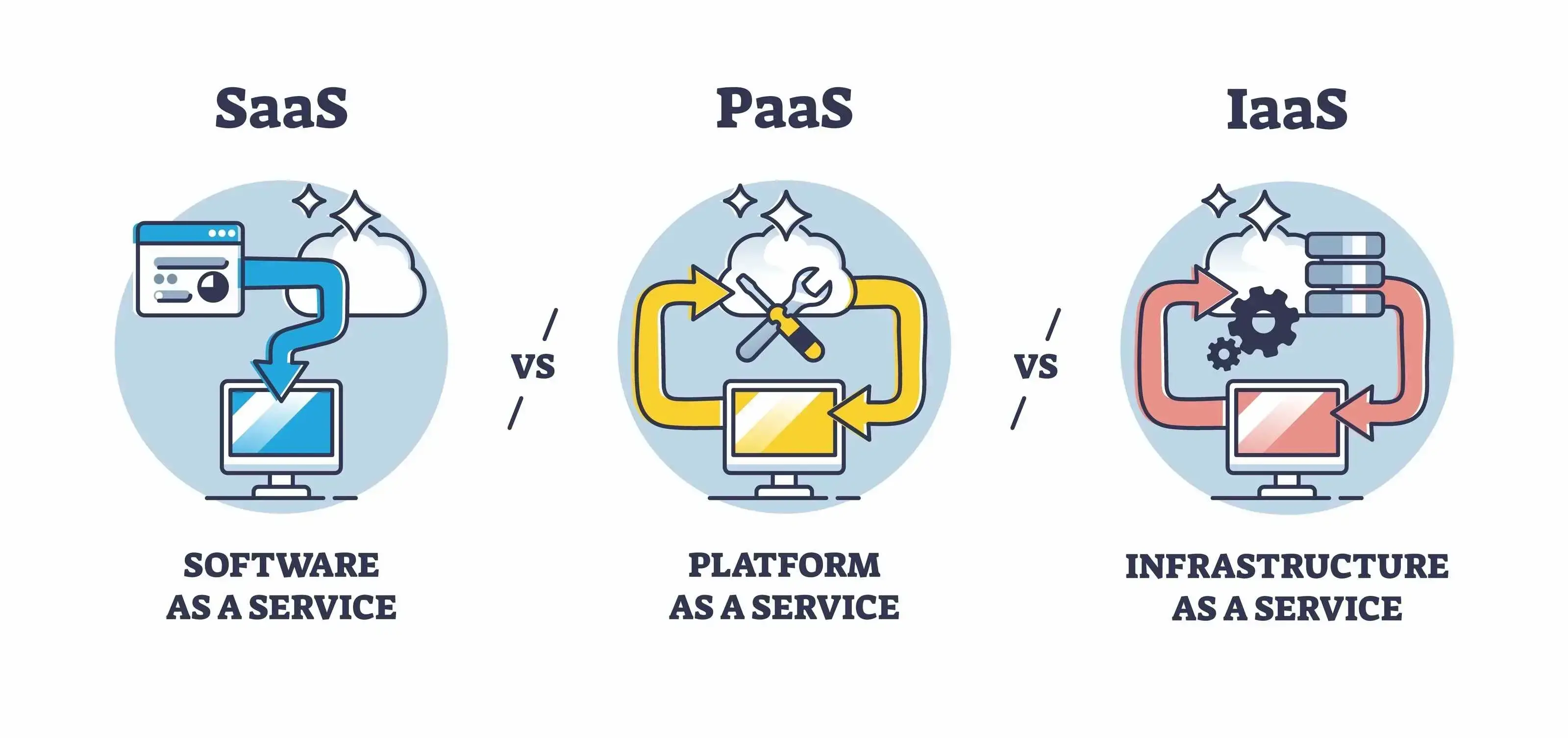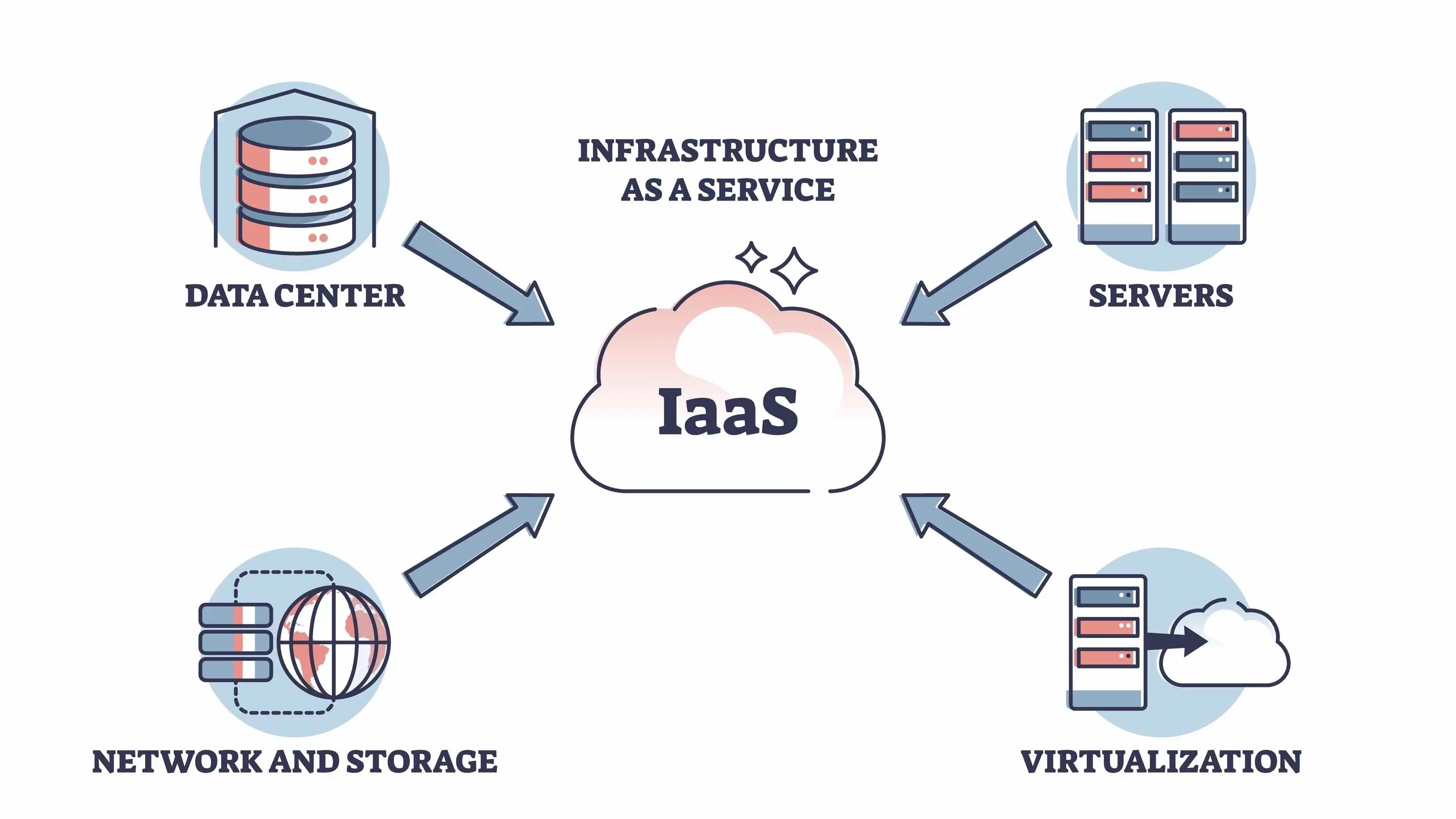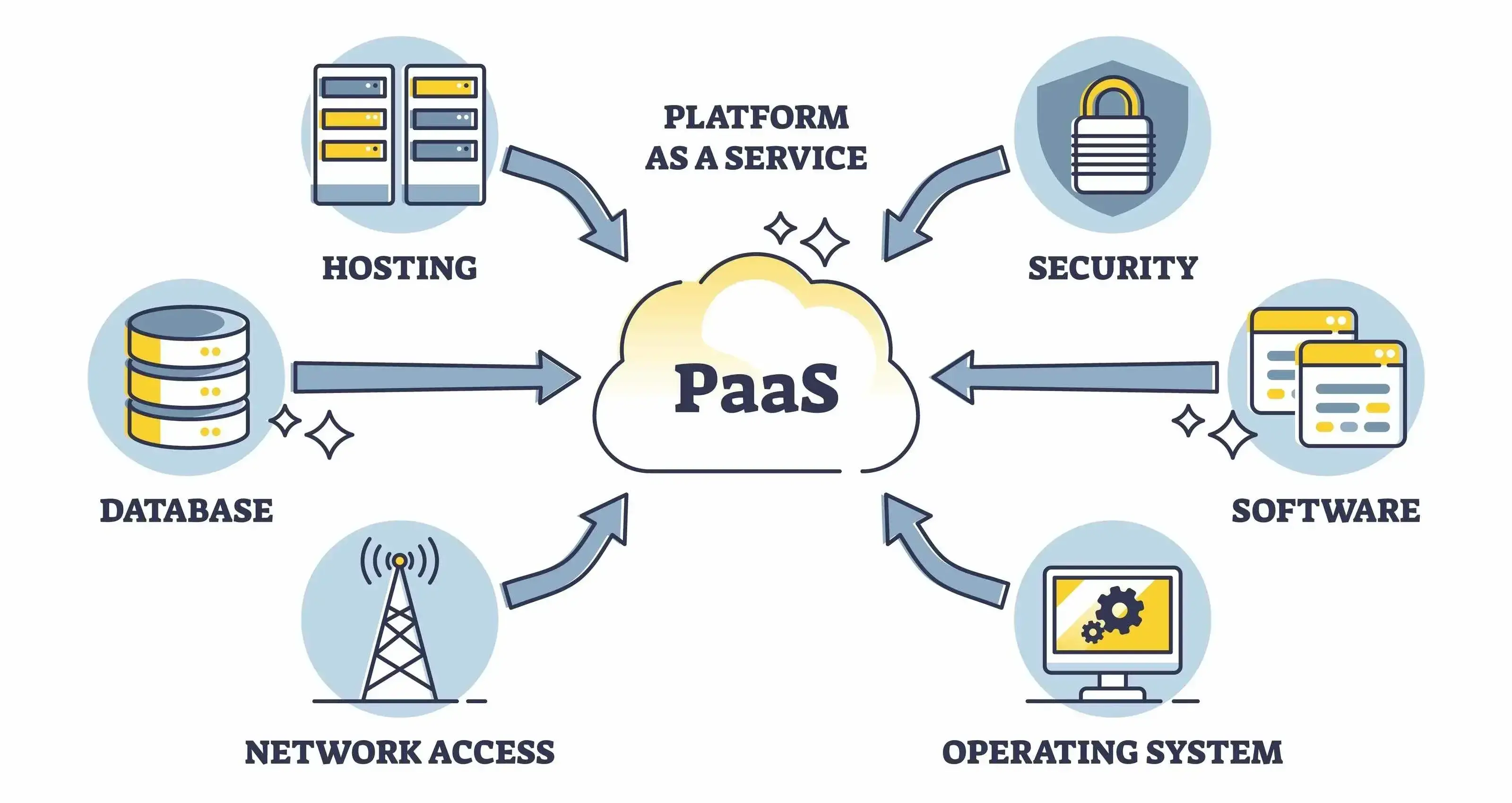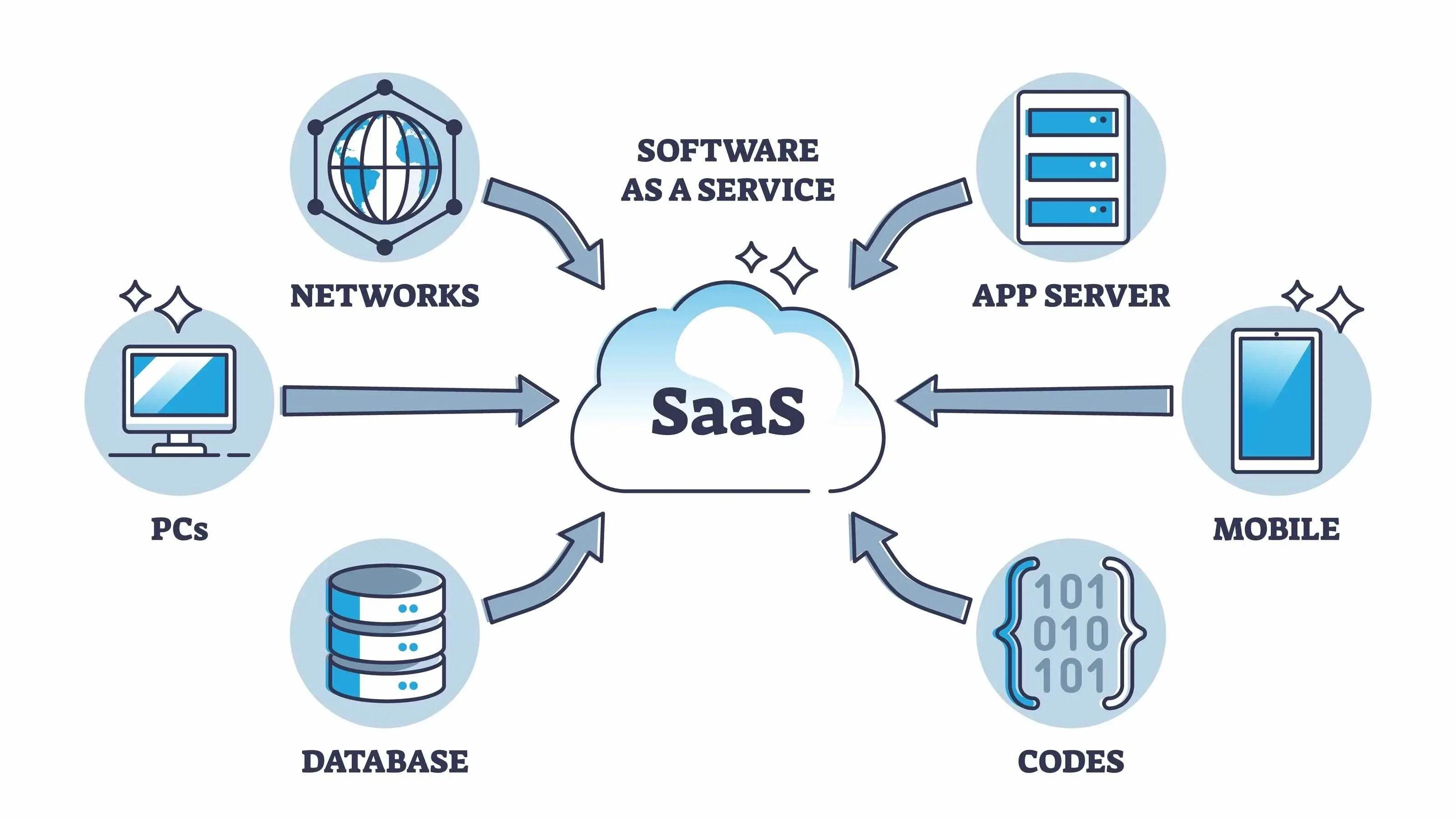The cloud offers opportunities for small businesses to expand cost-effectively and enables large enterprises to operate more efficiently.
As of 2024, approximately 94% of companies use cloud services.
Given the extensive nature of cloud technology, this article will specifically focus on comparing the three primary cloud models: IaaS, PaaS, and SaaS.
What Is IaaS?
IaaS (Infrastructure as a Service) is a cloud service that provides virtual machines, storage, and networking over the internet.
It enables users to access physical and virtual servers and resources on-demand.
Users pay on a pay-as-you-go basis, and you pay only for the amount of resources you need. It’s a big market, estimated to be valued at over $201 billion by 2027.
What Is PaaS?
PaaS (Platform as a Service) is a cloud model that offers developers tools and platforms to build and manage applications without handling the underlying hardware and software.
The PaaS provider maintains and manages the servers and data centers.
As of 2024, around 33% of cloud service users are using Platform as a Service (PaaS) solutions.
What Is SaaS?
Software-as-a-Service or SaaS delivers software applications via the Internet like a service.
The provider manages the applications, allowing users to access it through a web browser without installing it on their devices
It is the most used cloud service model, with the SaaS industry growing by 18% each year.
Examples of IaaS, PaaS, and SaaS

Some of the most popular IaaS, PaaS, and SaaS providers are:
IaaS
- DigitalOcean
- Linode
- Rackspace
- Amazon Web Services (AWS)
- Cisco Metapod
- Microsoft Azure
- Google Compute Engine (GCE)
- Amazon EC2
- Alibaba Elastic Compute Service
- IBM Cloud
- Vultr
- OVHcloud
- Oracle Cloud
- Google Cloud
- Hetzner Cloud
- Scaleway
- CenturyLink Cloud
- Tencent Cloud
PaaS
- AWS Elastic Beanstalk
- Windows Azure
- Heroku
- Force.com
- Google App Engine
- Apache Stratos
- OpenShift
- IBM
- Oracle Cloud Platform
- Red Hat OpenShift
- SAP Cloud Platform
- Mendix
- Engine Yard
- Jelastic
SaaS
- Google Workspace
- Dropbox
- Salesforce
- Cisco WebEx
- Concur
- GoToMeeting
- Zoom
- MailChimp
- Adobe Creative Cloud
- Github
- Xero
- JetBrains
- Slack
- HubSpot
- Asana
- Shopify
- Microsoft 365
Differences Between IaaS, Paas, and SaaS
Now, onto the technical differences between IaaS, PaaS, and SaaS:
| Aspect | IaaS | PaaS | SaaS |
|---|---|---|---|
| Applications | Managed by the user; IaaS provides infrastructure for large-scale web applications. | Managed by the user; PaaS tools often used for mobile application development. | Managed by the provider; also called web-based or on-demand software. |
| Data | Managed by the user; eliminates costs of physical servers; more scalable. | Managed by the user; cheaper than IaaS; built-in scalability, reliability, and fault tolerance. | Managed by the provider; handles large data volumes; accessible from any device. |
| Runtime | Managed by the user; paid by the hour for computer environments. | Managed by the provider; limits users to a specific application framework. | Managed by the provider; included in the SaaS product. |
| Middleware | Managed by the user; lies between OS and applications. | Managed by the provider; users don't handle it. | Managed by the provider; improves flexibility with tenant-specific customizations. |
| Operating System | Managed by the user. | Managed by the provider. | Managed by the provider. |
| Virtualization, Servers, Storage, Networking | Handled by the provider; users assured of operation. | Handled by the provider. | Handled by the provider. |
IaaS vs. PaaS
| Aspect | IaaS | PaaS |
|---|---|---|
| Control over Operating Systems | Users have more control over operating systems. | Less control over operating systems. |
| Flexibility and Ease of Navigation | Less flexible and harder to navigate. | More flexible and easier to navigate. |
| Primary Function | Emulates the infrastructure of a cloud-based technology. | Helps developers create custom applications using an API delivered through the cloud. |
| Purpose | Basis for creating a cloud-based service for content, software, websites, etc. | Platform for developers to create applications without hosting them. |
SaaS vs. PaaS
| Aspect | SaaS | PaaS |
|---|---|---|
| Management | Entirely managed by the service provider, including data, servers, OS, and more. | Managed by the service provider, but used by developers to create new products. |
| Primary Use | Used to provide a service directly to users. | Used as a basis for creating new applications. |
| Platform | Runs on the service provider's infrastructure. | Serves as the platform for app development. |
| Target Users | Ideal for companies that need easy-to-use solutions. | Best for companies wanting to create their own solutions on an existing network. |
IaaS vs. SaaS
| Aspect | IaaS | SaaS |
|---|---|---|
| Core Service | Managing and maintaining computing resources like servers, hardware, software, networks, etc., in the cloud. | Delivering software to users via an Internet connection. |
| User Responsibilities | Managing the OS, applications, middleware, and data. | Using the provided software. |
| Provider Responsibilities | Takes care of servers, hardware, software, networks, and more. | Manages everything related to the software. |
| Payment Model | Users pay based on resource usage (e.g., hourly). | Users pay for services via a monthly subscription. |
When is IaaS the Right Choice?

When you have a small company or a start-up because IaaS helps you to reduce the time and money that you would spend on buying and building hardware and software
When you have a large company and want complete control over your applications and infrastructure. Also, if you want to buy only the amount of resources your company needs and nothing more.
When your company is growing rapidly, IaaS offers excellent scalability and lets you easily change hardware or software as needed.
When you need to run temporary or experimental projects, IaaS allows you to quickly set up and shut down environments without major costs.
When you require strong disaster recovery and backup solutions, IaaS provides flexible options to keep your data safe.
When you have unpredictable workloads, IaaS can handle changes in demand, ensuring your system runs smoothly without overbuying resources.
When is PaaS the Right Choice?

If you are a developer working with others, PaaS is ideal as it streamlines workflows and provides superior speed and flexibility.
If you want to create a custom application, PaaS is the best option for you.
If you need a service for fast app development and deployment, while reducing costs and simplifying issues, PaaS is the way to go.
If you need easy integration with databases and other tools, PaaS offers built-in support.
If you are focusing on microservices and containerized applications, PaaS helps manage these efficiently.
If you want automatic scaling and load balancing for your applications, PaaS handles these tasks for you.
When is SaaS the Right Choice?

If you have a small company or start-up aiming to launch eCommerce quickly without dealing with server or software issues, SaaS is an excellent solution.
If you are working on a short-term project that demands fast, cheap, and straightforward collaboration, SaaS can help you with all of this.
If you run applications that are not frequently used.
If you have an application that requires web and mobile access, SaaS is the solution for you because it provides you with the proper tools.
If you need to quickly implement software without worrying about maintenance and updates, SaaS takes care of everything.
If you want automatic updates and maintenance, SaaS takes care of these tasks without requiring your intervention
XaaS: Anything as a Service
XaaS stands for Anything-as-a-Service, where "X" can be any product. It includes various tools, applications, services, and games, all delivered via the cloud.
Users pay for XaaS via a flexible consumption model, so they do not have to pay for the service upfront or purchase a license.
XaaS offers several benefits, including cost savings, faster app and business process development, and shifting IT resources to higher-value projects.
Some of the most common types of XaaS include:
- Software as a Service (SaaS),
- Platform as a Service (PaaS),
- Infrastructure as a Service (IaaS),
- Storage as a Service (StaaS),
- Database as a Service (DBaaS),
- Disaster Recovery as a Service (DRaaS),
- Communications as a Service (CaaS),
- Network as a Service (NaaS),
- Data as a Service (DaaS), etc.
Some of the most popular XaaS providers are Auvik, AWS, Microsoft Azure, Google Cloud Platform (GCP), Salesforce, Oracle Cloud, etc.
Evaluating Cloud Service Providers: Key Factors to Consider

Let’s quickly review the key factors you should consider when evaluating a cloud service provider.
Reliability and Uptime
Ensure the provider guarantees high availability and uptime through Service Level Agreements (SLAs).
Look for a track record of minimal downtime and quick recovery times.
Security and Compliance
Check for robust security measures, including encryption, access controls, and regular security audits.
You should also verify compliance with industry standards and regulations relevant to your business, such as GDPR, HIPAA, or ISO 27001.
Cost and Pricing Models
Compare pricing structures, including pay-as-you-go, subscription-based, and reserved instances.
Consider total cost of ownership, including potential hidden fees for data transfer, storage, and support.
Scalability and Performance
Assess the provider's ability to scale resources up or down based on your needs.
A general rule of thumb is to evaluate performance metrics, such as speed, latency, and overall responsiveness.
Customer Support and Service
Look for providers offering 24/7 customer support with various contact methods (phone, chat, email). Consider the quality of support, including response times and expertise.
Data Management and Storage
Ensure the provider offers flexible and reliable data storage options. Look out for backup and recovery solutions to safeguard against data loss.
Integration and Compatibility
Verify that the provider’s services are compatible with your existing systems and applications.
Look for robust APIs and integration options to facilitate easy connectivity and onboarding.
The Importance of Cloud Service Level Agreements (SLAs)
Service Level Agreements (SLAs) are crucial in defining the expectations and responsibilities between cloud service providers and their clients.
Here's why SLAs are important:
Performance Guarantees: SLAs specify the expected performance levels, such as uptime and response times, ensuring that the provider meets the agreed standards.
Accountability and Responsibility: They outline the responsibilities of both the provider and the client, making it clear who is accountable for various aspects of the service.
Compensation and Remedies: SLAs detail the compensation or remedies available if the provider fails to meet the agreed performance standards, protecting the client’s interests.
Service Scope and Boundaries: They clearly define what is included in the service, avoiding misunderstandings about the provider's obligations and the client's expectations.
Monitoring and Reporting: SLAs include provisions for regular monitoring and reporting of performance metrics, ensuring transparency and continuous service improvement.
Dispute Resolution: They establish a framework for resolving disputes related to service performance, providing a structured approach to handle conflicts.
Compliance and Security: They ensure that the provider adheres to necessary compliance and security standards, safeguarding the client's data and operations.
Support and Maintenance: SLAs outline the level of support and maintenance provided, ensuring that the client receives timely assistance and issue resolution.
Final Remarks
Overall, different cloud services cater to varying companies' needs and sizes.
Ultimately, only you can choose the best cloud service based on your specific needs.
So, the first thing you should do is determine your business priorities and needs—after this, picking a cloud service should be quick and simple!
Frequently Asked Questions
Do I need technical knowledge to use cloud hosting?
Not necessarily. Under a fully managed hosting package Verpex will take care of all the technical aspects for you.
Why should I try a managed cloud server?
We’d highly recommend using a managed service, especially if you don’t have the technical skills to run a website. It might cost a little extra, but it certainly takes the stress out of site management.
How easily can I switch between VPS and cloud hosting?
Generally, there shouldn’t be an issue when switching. However, if you’ve done a lot of heavy customization to your VPS solution you might find making the switch a little more time-consuming.
How easy is it to switch from dedicated to cloud?
This depends on how complex your site is. As lots of websites on dedicated servers are highly customized, it could take longer to transfer everything over.
How do cloud SLAs affect my business's risk management strategy?
Cloud SLAs affect your business's risk management strategy by clearly defining performance expectations, accountability, and remedies for service failures.
They provide transparency, ensuring the provider meets agreed standards, which mitigates risks related to downtime and service interruptions.
What role do APIs play in cloud service integration?
APIs facilitate easy integration between cloud services and existing systems by allowing different software applications to communicate, enabling automation, customization, and enhanced functionality.

I've been navigating the web hosting waters for years now. As the Chief Editor at Verpex, I team up with some awesome writers to dish out the good stuff on hosting. Got a Master's in Journalism, so I always have an eye out for quality. Whether you're just dipping your toes or you're a seasoned surfer, I'm here to make everything web hosting feel like a breeze
View all posts by Julia Lozanov





















